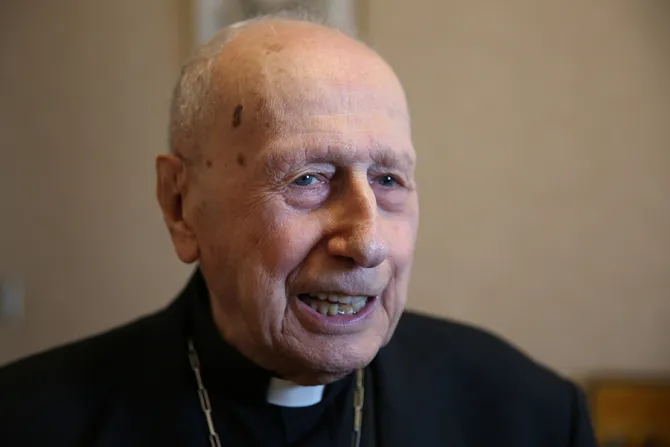Vatican City, Jan 26, 2017 / 06:10 am
As Cardinal Roger Etchegaray leaves Rome to retire to France, his homeland, an era has closed.
He was a bishop without emblem or motto, but he was committed to peace and to the human person. Cardinal Etchegaray epitomizes all the characteristics of the modern Church. If there is something we deem to be new, it is possible he had done it already.
The news of Cardinal Etchegaray's departure was spread by Angelo Scelzo, former deputy director of the Holy See Press Office and a good friend of the cardinal. Scelzo penned a Jan. 20 article on the Italian Bishops Conference's newspaper Avvenire and reported that, before leaving, Cardinal Etchegaray was able to say goodbye both to Pope Francis and Pope emeritus Benedict.
Why was Cardinal Etchegaray so important for the life of the Church?
A smart French priest with a profound human touch, Cardinal Etchegaray was born in 1922 in the southwestern French town of Espelette, the first of three children. Ordained a priest in 1947, he was among the Second Vatican Council's experts, called "periti," and also Vicar for Catholic Action. He served as deputy and secretary general of the French Bishops' Conference from 1961 to 1969. He was Archbishop of Marseille from 1970 to 1985 before entering the Roman Curia.
In Rome, he served as president of the Pontifical Councils for Justice and Peace from 1984 to 1998 and headed Cor Unum from 1984 to 1995. To some extent, by assuming both the posts of the Vatican dicasteries for charities and international works, Cardinal Etchegaray anticipated the current Curia reform that places them in the same sphere of responsibility.
But this just a minor observation in a whole life whose deeds marked an era of the Catholic Church.
Cardinal Etchegaray, 94, now leaves his house in Piazza San Calisto to return to Bayonne, in France, where he will live out his life with his sister in a retirement home
There are many reasons this retirement means the end of an era.
This is evident in his home, full of books, memories and history. And among the memories, there was a Nativity artwork displayed in the dining room. That Nativity was donated to him by Fidel Castro. If the Church can now have an impact on Cuba's life and current developments, it is because Cardinal Etchegaray worked out the first steps there.
Cardinal Etchegaray went to Cuba for the first time in 1989. At the time, he was serving as president of the Pontifical Council for Justice and Peace. The trip was kept secret, as it presented many difficulties. For instance, state atheism was the official religion in Cuba until 1992.
In 1989 John Paul II sent Cardinal Etchegaray to Cuba to build bridges. It was Christmas time, and Cardinal Etchegaray could celebrate a Mass in a crowded Cathedral of Habana.
At the end of the Mass, Cardinal Etchegaray "posed a crowd-pleasing question: 'What message shall I take to the Pope?' 'That he come! That he come! That he come!' thousands of voices roared in unison. 'I hear your message,' replied Etchegaray, 'I don't know what he will say, but I am certain he will come'," according to the Los Angeles Times.
That was the first of many trips to Cuba that eventually found fruition in the first, historic visit of a Pope in to the island in 1998.
Cardinal Etchegaray's lifestyle shows his impact on the era.
As Pope Francis encourages a sober style of life, asks Christians to commit to the poor, preaches conversion and a flight from worldliness, it must be remembered that Cardinal Etchegaray, once he was ordained bishop in 1969, never wanted an emblem or a motto. When asked about that decision, he said that "having an emblem and a motto seems to me an inheritance of the medieval past." He was among the very few who made such a symbolic decision.
(Story continues below)
Back in 1986, Cardinal Etchegaray was among the organizers of the first meeting of the world's religions in Assisi, and he took part in all the other meetings. Although that first meeting was strongly criticized within the Curia, he was held in great esteem not just by the Pope, but by many Curia members.
In 1997, he was called to preach the Lenten Spiritual Exercises to the Curia. He presented a reflection focused on Jesus "True God and true man," linked by a guiding line, a sentence of the French philosopher Blaise Pascal: "Outside of Jesus Christ, we do not know who God is, nor who we are.
The spirit of the cardinal's life has always aimed to build bridges. He was sent as papal envoy to Iraq to attempt to avoid the Second Gulf War in 2002. He traveled through China four times (in 1980, 1993, 2000, and 2003) in order to try to better understand the situation of the Church of China and eventually improved relations with the country.
He was the man two Popes turned to in scenarios of crisis. At the same time, he was a good friend to Pope Paul VI, whom he described as "a very discreet, very reserved Pope, who became a wanderer Pope, the first Pope to take the plane, the first Pope to go to the Holy Land, the first Pope to go to the United Nations," and who "had taught the truth of humanity to all men, and he went toward the poorest."
Before leaving Rome, Cardinal Etchegaray was also able to say goodbye to the Pope emeritus Benedict XVI. To Benedict, he has a special link: on Christmas Eve 2009, Cardinal Etchegaray was seriously injured as a person unsuccessfully attacked Benedict XVI during the procession into Mass.
Now Cardinal Etchegaray is not leaving on a mission for the Church, but he returns home, to Bayonne, to live with his beloved sister Maite.



